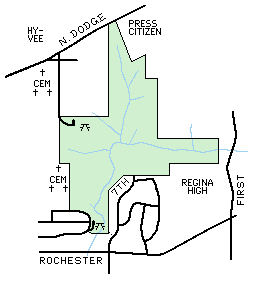
Hickory Hill Park Woods is a diverse 190 acre area of wooded ravanes, scrub and open fields on the northeast side of Iowa City, irregularly shaped, and stretching about a mile from north to south,

There are two major public access points, each with a parking lot, picnic shelter and an area of groomed lawn. One is at the east end of Davenport Street, and the other is at the south end of Conklin Lane (off of North Dodge Street, just east of the cemetary and across the street from the Hy-Vee supermarket. Public Access is also possible from North First Avenue, North Dodge Street, and North 7th Avenue, but these access points are, at best, poorly developed.
Hickory Hill Park is largely composed of severely disturbed woodland pasture that is slowly recovering. In some areas, this recovery is nerely complete, and except for lost diversity, the area appears to be a healthy mature forest. In other areas, the recovery has only begun; cattle grazing continued in the north part of the park without city permission into the early 1990's!
The north branch of Ralston creek flows through the park, and tributary streams flow through the park from the north; along the creek, there are small floodplains, and in the extreme north of the park, there is a small system of wetlands. There is a dam and stormwater retention basin in the east arm of the park; this was built in the 1980's to help control flash floods along Ralston Creek; normally, the basin behind the dam is dry, but when there is a storm, the dam will back up a fairly large temporary pond.
There is a small population of beavers that occasionally moves up Ralston Creek into the park. ``Beaver chews'', trees that have been gnawed on or even cut down, are the most common evidence of beaver activity found along the creek. Although there are occasional stories of beaver dams along the creek, most of the log dams found along Ralston Creek are ``debris dams'', piles of sticks and branches that have lodged on some obstruction during a flood.
An old railroad right-of-way cuts across the north end of the park, roughly parallel to North Dodge Street; over a century ago, grading along this right of way was abandoned, and no rails were ever laid. Today, a high fill and shallow roadcut mark the path of this ill-fated venture.
Hickory Hill Park is a favorite site for birdwatchers, and it is a refuge for urban deer. It has a dense network of trails, some officially developed, and many more created by repeated trampling. It is difficult to maintain an up-to-date trail map for the park, and the trail network is complex enough that getting lost is fairly easy!
Hickory Hill park offers significant rewards to the visitor at all times of year. When the snow permits, it is an excellent cross country skiing area; in the spring, migratory birds find it a pleasant resting place, and in the summer, the shaded trails along the creek and through the woods offer a pleasant alternative to the surrounding urban area. The fall color show in the park is quite nice, and in both the spring and fall, there are many varieties of mushrooms to be found.
Hickory Hill Park has grown in stages, starting with a 40 acre core purchased in 1927 with cemetery expansion bonds; 50 acres were added to this in 1952, a small tract was added in 1968, and in the 1980's, as part of a federal grant to Iowa City for improved stormwater management, the park was expanded to its current size, although the stormwater management areas were only formally added to the park in 1992.
Development around Hickory Hill threatens to spoil many of the abutting natural areas. The old Goosetown neighborhood to the west was established a century ago, but to the east, intensive development only began in the 1980's. Some of the still undeveloped tracts to the north and west include wooded ravines that, if destroyed, could seriously detract from the park's value to wildlife.
The urban deer herd cannot grow unchecked forever; deer evolved under immense predator pressure, and in urban areas, the only predator faced by the deer are automobiles.
The quality of water in the North Branch of Ralston Creek appears to be very poor and will probably decline as wild areas upstream from the park are urbanized.
As more and more people discover this park, erosion of trails and the creation of additional trails by people walking off of the developed trails threatens the nature of the park. Gully erosion along some of the sloping trails in the park has been extremely severe!
Iowa City's Oakland Cemetery, to the west of the park, is almost full; the original purchase of the park with money from the sale of cemetery expansion bonds makes it very natural that the city should look to Hickory Hill park for additional space when the cemetery fills. How the city will balance the need for cemetery expansion with the current wild character of the park remains to be seen.
Hickory Hill Park is managed by the Iowa City Parks and Recreation Department, (319)356-5110. The Picnic shelters may be reserved by calling 356-5100.
The Friends of Hickory Hill maintains a website and is dedicated to monitoring and working to preserve Hickory Hill Park.